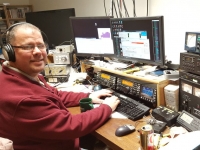

Here are some various helpful tidbits submitted by our members that will help you improve your station and your score.
Contributed by K9EL
Experience #1: It is often difficult to spot miniscule cracks in the outer shield that will let moisture in the cable. Just measuring loss or SWR does not tell the whole picture. I made a 20 foot jumper from old coax to connect my SixPack to my second radio. I noticed a higher noise level on the 2nd radio compared to the main radio at higher frequencies. I replaced the jumper with new coax and the noise disappeared. Even though the loss and SWR appeared OK, the shield on the old cable was obviously not very effective. A few years ago, I removed all my old RG8 type coax from my tower and gave it away. Now some of my competition is using crappy cable.
Experience #2: A friend was complaining that signal levels were down on the higher bands. He said his coax was about 30 years old. I told him to remove the coax from the antenna and leave it open circuit. I told him to check the SWR – it was 3:1!!! That is a good easy and quick check for coax – leave the cable open at the far end and check the SWR. Ideally, it will be very high. If you have an antenna analyzer, sweep the bands up to VHF. If the SWR drops noticeably, I suggest replacing the coax.
Experience #3: Was getting flaky SWR readings as I changed frequency, yet the measured loss was OK. Using a TDR, it turns out there was an impedance bump in the cable. So, at certain frequencies, it affected the SWR although the bump had little impact on the total loss. RG8 type cables are susceptible to this from tape or wire hangers that are too tight. Over the years, the cable can get compressed in places – especially if you use foam coax (never use foam coax IMHO). Also, do not put any sharp bends in coax. It was not designed to do 90 degree turns. Use extra cable and make a loop to do bends.
Optimizing your station means optimizing every piece of your station. Why spend thousands of dollars on antennas and radios, and then use 20 year old cable to connect them? Ever since I bit the bullet and installed 1/2 inch Heliax to my antennas and double shielded cable for jumpers in the station, I have had no problems.
Contributed by K9MA
If the SWR of your antenna seems a lot lower than it was 10 years ago,
and nothing else has changed, you probably need to replace the coax.
One way to measure the loss easily is to measure the SWR or return loss
with an antenna analyzer at some frequency at which the antenna on the
other end is badly mismatched. Scan a range of out-of-band frequencies,
and look for the highest SWR. Don’t use
an ordinary SWR bridge, as it probably won’t accurately measure the
high SWR, but a good antenna analyzer should.
https://www.amphenolrf.com/vswr-conversion-chart/
The coax loss is half the return loss. For example, if the maximum SWR
is 1.9:1, the return loss is about 10 dB, so the coax loss would be 5 dB
at that frequency. Coax loss in dB goes about as the square root of
frequency, so you can correct for the band
of interest. For example, if you measured the peak SWR of 1.9:1 at 24
MHz, the coax loss at 28 MHz would be about 5.4 dB.
Note that these measurements will give you an upper limit on the coax
loss. If the antenna isn’t badly mismatched at some frequency, the
measurement will suggest that the loss is greater than it really is. A
matched dummy load, for example, would have a 1:1
SWR and infinite return loss.
If it’s convenient to do, of course, you could just short the far end of the coax before making the measurement.